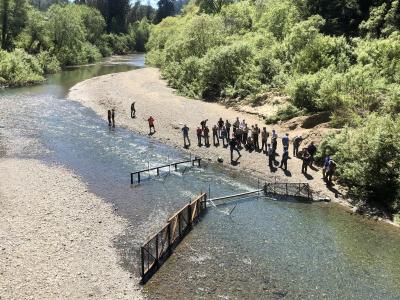Holding Space—Restoring Habitat and Making Room for Innovation
March 26 - 29, 2024
From Groundwater to Streamflow: Exploring the Science, Projects and Policies to Manage Groundwater Resources to Support Streamflows for Salmon and Public Trust Resources
29 March 2024
9:00am - 5:00pm
Session Coordinators: Monty Schmitt, The Nature Conservancy; Matt Clifford, Trout Unlimited; and David Dralle, US Forest Service Pacific Southwest Research Station
Groundwater contributions to instream flows, particularly in the dry season, are essential for the restoration of rivers and the recovery of salmonid populations. Historic logging practices, changes in land use, the legacy of fire exclusion, and increasing well diversions have all contributed to depleted streamflows. Efforts to manage groundwater resources, like the Sustainable Groundwater Management Act and recent efforts by county planning departments, have yet to address the complex technical and regulatory issues associated with avoiding or mitigating existing cumulative impacts and permitting for new wells. Additionally, existing state-wide legislation manages for groundwater only in large groundwater basins like the Central Valley, neglecting the essential role of hillslope groundwater systems in the small headwater watersheds that support salmon populations. Increasingly, groundwater infiltration and recharge projects are being proposed, but securing permits for restoration actions and predicting the benefits of actions are not always straightforward. This session addressed three main challenges and explored solutions regarding: groundwater modeling of streamflow depletion in diverse (geology, biome, etc) landscapes; designing and permitting infiltration and flood recharge projects; and efforts to develop county groundwater well ordinances to protect public trust resources.
Evaluating Hydrologic Effects of Scott and Shasta River Irrigation Curtailments Using Remote Sensing and Streamflow Gages, Eli Asarian, Riverbend Sciences
Small-Scale Groundwater Recharge Opportunities for Streamflow Augmentation, Little Mill Creek, Navarro River Watershed, Christopher Woltemade, Ph.D., Prunuske Chatham, Inc.,
Regional Approaches to Groundwater Management to Mitigate Streamflow Depletion: Case Studies from Napa, Sonoma, and Lake Counties, Matthew O'Connor, O’Connor Environmental, Inc
Incorporating Site Characterization into Natural Landscape Engineering and Streamflow Enhancement Projects: Case Studies from the Upper Mattole Watershed, Tasha McKee Sanctuary Forest, Inc; and Wyeth Wunderlich EBA Engineering
An Overview of Existing Legal and Policy Tools for Regulating Groundwater Withdrawals to Protect Surface Streamflow in California, Matthew Clifford, J.D. Trout Unlimited and Redgie Collins, J.D., California Trout
Groundwater into Streamflow: Principles and Guidelines for Cities and Counties to Develop Well Ordinance to Protect Streamflow for Salmon Habitat, Monty Schmitt, The Nature Conservancy
Unified Modeling Approaches to Estimating Streamflow Depletion Due to Groundwater Pumping, Nick Murphy, The Nature Conservancy
The Other Water Users: How Plant and Human Water Use Impact Streams, Dana A Lapides; USDA-ARS Southwest Watershed Research Center
Quantifying Streamflow Depletion from Groundwater Pumping Using Storage-Discharge Functions in Headwater Catchments, Phil Georgakakos PhD, UC Berkeley
Approaches for Evaluating Streamflow Depletion; Shedding Some Light on the Secret, Occult, and Concealed Nature of Surface Water/Groundwater Interactions, Jeremy Kobor, MS, PG, Senior Hydrologist, OEI, Inc
Process Controls on Low Flows in Salmon-Supporting Headwater Catchments: What do we Know (and Not Know, but Could) that Can Help Inform Management?, David Dralle PhD, USDA Forest Service
Effects of Short-Term Flow Reductions on Juvenile O. mykiss: An Experiment at the Sierra Nevada Aquatic Research Lab, Kelly Goedde-Matthews, UC Davis Center for Watershed Sciences

